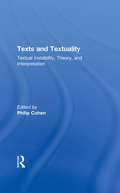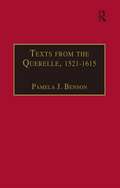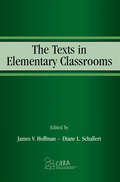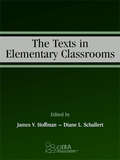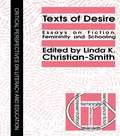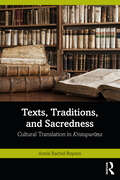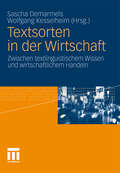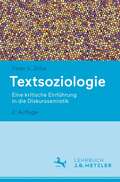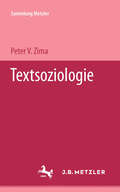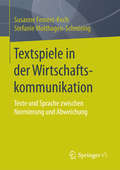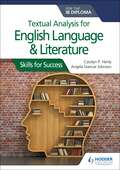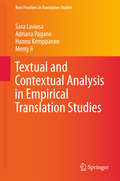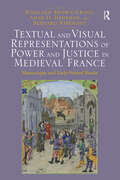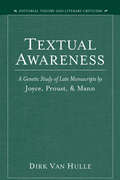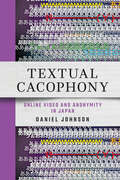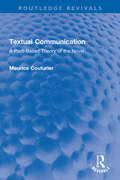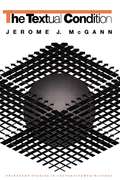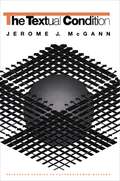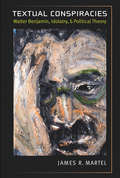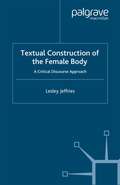- Table View
- List View
Texts and Textuality: Textual Instability, Theory, and Interpretation (Wellesley Studies in Critical Theory, Literary History and Culture #Vol. 13)
by Philip G. CohenThese essays deal with the scholarly study of the genesis, transmission, and editorial reconstitution of texts by exploring the connections between textual instability and textual theory, interpretation, and pedagogy.What makes this collection unique is that each essay brings a different theoretical orientation-New Historicism, Poststructuralism, or Feminism-to bear upon a different text, such as Whitman's Leaves of Grass, Faulkner's The Sound and the Fury, or hypertext fiction, to explore the dialectical relationship between texts and textuality.The essays bring some of the textual theories that compete with each other today into contact with a broad range of primarily literary textual histories. That texts are intrinsically unstable, frequently consisting of a series of determinate historical versions, has consequences for all students of literature, because different versions of a literary work frequently help shape different readings independently of the interpretations brought to bear upon them. Textual instability of the works is relevant to our understanding of how the meanings of texts are generated. The contributors build on the numerous challenges to the Anglo-American editorial tradition mounted during the past decade by scholars as diverse as Jerome McGann, D.F. McKenzie, Peter Shillingsburg, D.C. Greetham, Hershel Parker, and Hans Walter Gabler. The volume contributes to the paradigm shift in textual scholarship inaugurated by these scholars. Index.
Texts from the Querelle, 1521–1615: Essential Works for the Study of Early Modern Women: Series III, Part Two, Volume 1 (The Early Modern Englishwoman: A Facsimile Library of Essential Works Series III, Part Two)
by Pamela J. BensonMisogyny and its opposite, philogyny, have been perennial topics in Western literature from its earliest days to the present day, but only at certain historic periods have pro-woman authors challenged fundamental negative assumptions about women by engaging in formal debate with misogynists and juxtaposing these two attitudes toward women in pairs or series of texts devoted exclusively to discussing womankind. This dialectic of attack on and defence of the female sex, known as the querelle des femmes (debate about women), was especially popular among authors and readers during the sixteenth and earlier seventeenth centuries in England. At least 36 texts exclusively devoted to attacking and/or defending women were published in the hundred years between 1540 and 1640. The works included in these two volumes exemplify the content and the methods of debate in England during those two centuries. Volume one includes texts from 1521 through to 1615.
Texts from the Querelle, 1521–1615: Essential Works for the Study of Early Modern Women: Series III, Part Two, Volume 1 (The Early Modern Englishwoman: A Facsimile Library of Essential Works Series III, Part Two #Vol. 1)
by Pamela J. BensonMisogyny and its opposite, philogyny, have been perennial topics in Western literature from its earliest days to the present day, but only at certain historic periods have pro-woman authors challenged fundamental negative assumptions about women by engaging in formal debate with misogynists and juxtaposing these two attitudes toward women in pairs or series of texts devoted exclusively to discussing womankind. This dialectic of attack on and defence of the female sex, known as the querelle des femmes (debate about women), was especially popular among authors and readers during the sixteenth and earlier seventeenth centuries in England. At least 36 texts exclusively devoted to attacking and/or defending women were published in the hundred years between 1540 and 1640. The works included in these two volumes exemplify the content and the methods of debate in England during those two centuries. Volume one includes texts from 1521 through to 1615.
The Texts in Elementary Classrooms
by James V. Hoffman Diane L. SchallertThis CIERA sponsored book is based on the premise that high-quality texts of all kinds are essential to good teaching in elementary classrooms. Experts on a variety of text-related topics were asked to summarize existing research and then apply it to literacy development in an "ideal" classroom. The most comprehensive and up-to-date book in its field, it moves progressively from an examination of discrete literacy processes and forms to a holistic overview and assessment of the classroom literacy environment. Content coverage in this outstanding new book includes: *Literacy Processes--Part I examines basic reading processes (instruction, comprehension, word recognition, fluency, and motivation) as they relate to text features.*Forms of Texts--Part II examines the wide variety of text types (fiction, nonfiction, leveled, local, and electronic) that comprise an effective classroom literacy program. Discussions include the nature of these texts, their qualities and quantities, how they fit into an instructional plan, and how a teacher might assess their effectiveness.*Text Selection--Part III examines special issues (linguistic diversity and teachers as censors) related to the selection of classroom texts.*Personal Applications--The final, hands-on chapter synthesizes the book's ideas and offers practical tools (checklists and inventories) whereby teachers can self-assess the literacy environment of their own classrooms.This book is suitable for anyone (graduate students, in-service reading specialists and curriculum directors, college faculty, and researchers) who deal directly with issues of classroom literacy.
The Texts in Elementary Classrooms
by James V. Hoffman Diane Lemonnier SchallertThis CIERA sponsored book is based on the premise that high-quality texts of all kinds are essential to good teaching in elementary classrooms. Experts on a variety of text-related topics were asked to summarize existing research and then apply it to literacy development in an "ideal" classroom. The most comprehensive and up-to-date book in its field, it moves progressively from an examination of discrete literacy processes and forms to a holistic overview and assessment of the classroom literacy environment. Content coverage in this outstanding new book includes: *Literacy Processes--Part I examines basic reading processes (instruction, comprehension, word recognition, fluency, and motivation) as they relate to text features.*Forms of Texts--Part II examines the wide variety of text types (fiction, nonfiction, leveled, local, and electronic) that comprise an effective classroom literacy program. Discussions include the nature of these texts, their qualities and quantities, how they fit into an instructional plan, and how a teacher might assess their effectiveness.*Text Selection--Part III examines special issues (linguistic diversity and teachers as censors) related to the selection of classroom texts.*Personal Applications--The final, hands-on chapter synthesizes the book's ideas and offers practical tools (checklists and inventories) whereby teachers can self-assess the literacy environment of their own classrooms.This book is suitable for anyone (graduate students, in-service reading specialists and curriculum directors, college faculty, and researchers) who deal directly with issues of classroom literacy.
Texts Of Desire: Essays Of Fiction, Femininity And Schooling
by Linda K. Christian-SmithFirst published in 1993. Routledge is an imprint of Taylor & Francis, an informa company.
Texts Of Desire: Essays Of Fiction, Femininity And Schooling
by Linda K. Christian-SmithFirst published in 1993. Routledge is an imprint of Taylor & Francis, an informa company.
Texts, Traditions, and Sacredness: Cultural Translation in Kristapurāṇa
by Annie Rachel RoysonThis book presents a critical reading of Kristapurāṇa, the first South Asian retelling of the Bible. In 1579, Thomas Stephens (1549–1619), a young Jesuit priest, arrived in Goa with the aim of preaching Christianity to the local subjects of the Portuguese colony. Kristapurāṇa (1616), a sweeping narrative with 10,962 verses, is his epic poetic retelling of the Christian Bible in the Marathi language. This fascinating text, which first appeared in Roman script, is also one of the earliest printed works in the subcontinent. Kristapurāṇa translated the entire biblical narrative into Marathi a century before Bible translation into South Asian languages began in earnest in Protestant missions. This book contributes to an understanding of translation as it was practiced in South Asia through its study of genre, landscapes, and cultural translation in Kristapurāṇa, while also retelling a history of sacred texts and biblical narratives in the region. It examines this understudied masterpiece of Christian writing from Goa in the early era of Catholic missions and examines themes such as the complexities of the colonial machinery, religious encounters, textual traditions, and multilingualism, providing insight into Portuguese Goa of the sixteenth and seventeenth centuries. The first of its kind, the book makes significant interventions into the current discourse on cultural translation and brings to the fore a hitherto understudied text. It will be an indispensable resource for students and researchers of translation studies, comparative literature, religious studies, biblical studies, English literature, cultural studies, literary history, postcolonial studies, and South Asian studies.
Texts, Traditions, and Sacredness: Cultural Translation in Kristapurāṇa
by Annie Rachel RoysonThis book presents a critical reading of Kristapurāṇa, the first South Asian retelling of the Bible. In 1579, Thomas Stephens (1549–1619), a young Jesuit priest, arrived in Goa with the aim of preaching Christianity to the local subjects of the Portuguese colony. Kristapurāṇa (1616), a sweeping narrative with 10,962 verses, is his epic poetic retelling of the Christian Bible in the Marathi language. This fascinating text, which first appeared in Roman script, is also one of the earliest printed works in the subcontinent. Kristapurāṇa translated the entire biblical narrative into Marathi a century before Bible translation into South Asian languages began in earnest in Protestant missions. This book contributes to an understanding of translation as it was practiced in South Asia through its study of genre, landscapes, and cultural translation in Kristapurāṇa, while also retelling a history of sacred texts and biblical narratives in the region. It examines this understudied masterpiece of Christian writing from Goa in the early era of Catholic missions and examines themes such as the complexities of the colonial machinery, religious encounters, textual traditions, and multilingualism, providing insight into Portuguese Goa of the sixteenth and seventeenth centuries. The first of its kind, the book makes significant interventions into the current discourse on cultural translation and brings to the fore a hitherto understudied text. It will be an indispensable resource for students and researchers of translation studies, comparative literature, religious studies, biblical studies, English literature, cultural studies, literary history, postcolonial studies, and South Asian studies.
Textsorten in der Wirtschaft: Zwischen textlinguistischem Wissen und wirtschaftlichem Handeln
by Sascha Demarmels Wolfgang KesselheimDie Erforschung von Wirtschaftstextsorten ist in besonderem Maße auf eine enge Verzahnung von wirtschaftlicher Praxis und linguistischer Wissenschaft angewiesen. Das gilt gerade auch dann, wenn es darum geht, Studierende in die erfolgreiche Produktion von Wirtschaftstexten einzuführen. Wie aber ist das Verhältnis zwischen Sprachwissenschaft, wirtschaftlicher Praxis und Lehre im Umgang mit Wirtschaftstextsorten zu bestimmen? Im vorliegenden Sammelband werden unterschiedliche Zugänge zum Gegenstand Wirtschaftstextsorten dargestellt, Spannungsfelder ausgeleuchtet und Übergänge zwischen den einzelnen Bereichen aufgezeigt.
Textsoziologie: Eine kritische Einführung in die Diskurssemiotik
by Peter V. ZimaIm Anschluss an Adorno, Bachtin und Greimas’ Strukturale Semiotik analysiert Zima die Einwirkung sozialer Entwicklungen und Konfliktlinien auf literarische (und theoretische) Diskurse. Dabei geht es ebenso um Gattungsentwicklungen wie um semantische und syntaktische Strukturen einzelner Texte. Stets wird versucht, Gesellschaft und Literatur über die Sprache miteinander zu vermitteln. Der Band bietet vertiefte Analysen zu Proust, Musil und Kafka. Die Neuauflage enthält neue Kapitel zu den Begriffen der soziolinguistischen Situation, des Soziolekts sowie der Intertextualität und dehnt die Textsoziologie auf die Institutionalisierung literarischer Sprachen aus.
Textspiele in der Wirtschaftskommunikation: Texte und Sprache zwischen Normierung und Abweichung
by Susanne Femers-Koch Stefanie Molthagen-Schnöring Annette Uphaus-Wehmeier Christina Vaih-BaurDas Buch zeigt die Bandbreite zeitgenössischer Textprodukte in der Wirtschaftskommunikation auf, die durch verschiedene Varianten des Spiels mit Sprache und Text beeindrucken und eine lebendige Textkultur illustrieren können. Texte in Unternehmenskommunikation und Werbung folgen vielfach festgelegten Mustern. Pressemeldungen, Editorials oder Werbeanzeigen z.B. bieten als konventionelle Textsorten recht klare Orientierungen zu ihrem Inhalt und ihrer Form. Andere Texte wiederum sind vor allem deshalb aufmerksamkeitsstark und attraktiv, weil sie von Normen abweichen und spielerisch mit Erwartungen an Texte und ihren konventionellen Gestaltungsprinzipien umgehen. Zeitungsbeilagen in Form von Liebesbriefen, schillernde Unternehmensstorys, lyrische Verse in einer Werbeanzeige oder Wirtschaftspublikationen als Comic Strip z.B. informieren und unterhalten zugleich.
Textual analysis for English Language and Literature for the IB Diploma: Skills for Success
by Carolyn P. Henly Angela Stancar JohnsonBuild confidence in a range of key textual analysis techniques and skills with this practical companion, full of advice and guidance from experienced experts.- Build analysis techniques and skills through a range of strategies, serving as a useful companion throughout the course - from critical-thinking, referencing and citation and the development of a line of inquiry to reflecting on the writing process and constructing essays for Paper 1 and Paper 2- Develop skills in how to approach a text using textual analysis strategies and critical theory, for both unseen texts (the basis of Paper 1) and texts studied in class- Concise, clear explanations help students navigate the IB requirements, including advice on assessment objectives and how literary and textual analysis weaves through Paper 1, Paper 2, the HL Essay, Individual Oral and the Learner Profile- Build understanding in how to approach texts so that students can write convincingly and passionately about texts through active reading, note-taking, asking questions, and developing a personal response to texts - Engaging activities are provided to test understanding of each topic and develop skills for the exam - guiding answers are available to check your responses
Textual and Contextual Analysis in Empirical Translation Studies (New Frontiers in Translation Studies)
by Sara Laviosa Adriana Pagano Hannu Kemppanen Meng JiThis book presents the state-of-art research in ETS by illustrating useful corpus methodologies in the study of important translational genres such as political texts, literature and media translations. Empirical Translation Studies (ETS) represents one of the most exciting fields of research. It gives emphasis and priority to the exploration and identification of new textual and linguistic patterns in large amounts of translation data gathered in the form of translation data bases. A distinct feature of current ETS is the testing and development of useful quantitative methods in the study of translational corpora. In this book, Hannu Kemppanen explores the distribution of ideologically loaded keywords in early Finnish translation of Russian political genres which yielded insights into the complex political relation between Finland and Russia in the post-Soviet era. Adriana Pagano uses multivariate analysis in the study of a large-scale corpus of Brazilian fiction translations produced between 1930s-1950s which is known as the golden age of Latin American translation. The statistical analysis detected a number of translation strategies in Brazilian Portuguese fictional translations which point to deliberate efforts made by translators to re-frame original English texts within the Brazilian social and political context in the first three decades under investigation. Meng Ji uses exploratory statistical techniques in the study of recent Chinese media translation by focusing three important media genres, i.e. reportage, editorial and review. The statistical analysis effectively detected important variations among three news genres which are analysed in light of the social and communicative functions of these news genres in informing and mobilising the audience in specific periods of time in Mainland China.
Textual and Visual Representations of Power and Justice in Medieval France: Manuscripts and Early Printed Books
by Rosalind Brown-Grant Anne D. Hedeman Bernard RibémontThoroughly interdisciplinary in approach, this volume examines how concepts such as the exercising of power, the distribution of justice, and transgression against the law were treated in both textual and pictorial terms in works produced and circulated in medieval French manuscripts and early printed books. Analysing texts ranging from romances, political allegories, chivalric biographies, and catalogues of famous men and women, through saints’ lives, mystery plays and Books of Hours, to works of Roman, canon and customary law, these studies offer new insights into the diverse ways in which the language and imagery of politics and justice permeated French culture, particularly in the later Middle Ages. Organized around three closely related themes - the prince as a just ruler, the figure of the judge, and the role of the queen in relation to matters of justice - the issues addressed in these studies, such as what constitutes a just war, what treatment should be meted out to prisoners, what personal qualities are needed for the role of lawgiver, and what limits are placed on women’s participation in judicial processes, are ones that are still the subject of debate today. What the contributors show above all is the degree of political engagement on the part of writers and artists responsible for cultural production in this period. With their textual strategies of exemplification, allegorization, and satirical deprecation, and their visual strategies of hierarchical ordering, spatial organization and symbolic allusion, these figures aimed to show that the pen and paintbrush could aspire to being as mighty as the sword wielded by Lady Justice herself.
Textual and Visual Representations of Power and Justice in Medieval France: Manuscripts and Early Printed Books
by Rosalind Brown-Grant Anne D. Hedeman Bernard RibémontThoroughly interdisciplinary in approach, this volume examines how concepts such as the exercising of power, the distribution of justice, and transgression against the law were treated in both textual and pictorial terms in works produced and circulated in medieval French manuscripts and early printed books. Analysing texts ranging from romances, political allegories, chivalric biographies, and catalogues of famous men and women, through saints’ lives, mystery plays and Books of Hours, to works of Roman, canon and customary law, these studies offer new insights into the diverse ways in which the language and imagery of politics and justice permeated French culture, particularly in the later Middle Ages. Organized around three closely related themes - the prince as a just ruler, the figure of the judge, and the role of the queen in relation to matters of justice - the issues addressed in these studies, such as what constitutes a just war, what treatment should be meted out to prisoners, what personal qualities are needed for the role of lawgiver, and what limits are placed on women’s participation in judicial processes, are ones that are still the subject of debate today. What the contributors show above all is the degree of political engagement on the part of writers and artists responsible for cultural production in this period. With their textual strategies of exemplification, allegorization, and satirical deprecation, and their visual strategies of hierarchical ordering, spatial organization and symbolic allusion, these figures aimed to show that the pen and paintbrush could aspire to being as mighty as the sword wielded by Lady Justice herself.
Textual Awareness: A Genetic Study of Late Manuscripts by Joyce, Proust, and Mann (Editorial Theory And Literary Criticism)
by Dirk Van HulleAware of the act of writing as a temporal process, many modernist authors preserved numerous manuscripts of their works, which themselves thematized time. Textual Awareness analyzes the writing processes in James Joyce's Finnegans Wake, Marcel Proust's À la recherche du temps perdu, and Thomas Mann's Doktor Faustus and relates these to Anglo-American, French, and German theories of text. By relating theory to practice, this comparative study reveals the links between literary and textual criticism. A key issue in both textual criticism and the so-called crisis of the novel is the tension between the finished and the unfinished. After a theoretical examination of the relationship between genetic and textual criticism, Dirk Van Hulle uses the three case studies to show how?at each stage in the writing process?the text still had the potential of becoming something entirely different; how and why these geneses proceeded the way they did; how Joyce, Proust, and Mann allowed contingencies to shape their work; how these authors recycled the words of their critics in order to inoculate their works against them; how they shaped an intertextual dimension through the processing of source texts and reading notes; and how text continually generated more text. Van Hulle's exploration of process sheds new light on the remarkable fact that so many modernist authors protected their manuscripts, implying both the authors' urge to grasp everything and their awareness of the dangers of their encyclopedic projects. Textual Awareness offers new insights into the artificiality of the artifact?the novel?that are relevant to the study of literary modernism in general and the study of James Joyce, Marcel Proust, and Thomas Mann in particular. Dirk Van Hulle is Assistant Professor of English and German Literature, University of Antwerp.
Textual Cacophony: Online Video and Anonymity in Japan
by Daniel JohnsonTextual Cacophony explores the behaviors and routines of communication within anonymous internet culture in Japan. Focusing on the video sharing website Niconico, social media aggregation sites, and the notorious 2channel message board, Daniel Johnson uncovers these sites' complex cultures of writing that obscure meaning through playful and opaque forms of deviant script and overwhelming waves of text. Those practices conflate language with images, meaning with play, and confound individual representation with aggregate forms of social identity. Johnson argues that online media cultures in and around Japan are entwined with a cultural logic and visual syntax of cacophony that expresses ambivalence toward representation, media form, and distinct experiences of time. This aesthetic of cacophony provides an alternative way of expressing social identity and belonging, with an unmarked sense of anonymity providing a counter-form to the dissolving institutions and relationships of neoliberal Japan. Textual Cacophony investigates what it means and feels like to participate in this influential online culture.
Textual Communication: A Print-Based Theory of the Novel (Routledge Revivals)
by Maurice CouturierFirst published in 1991, Textual Communication examines the character and development of the novel from Richardson to Nabokov in relation to the printing and publishing industry. The book blends literary theory with a historical analysis of communication, carrying the debate on the novel beyond the pioneering work of Booth and Genette, while responding to and taking issue with the writings of Foucault, Baudrillard, McLuhan, and Barthes. It analyses the structures of the industry which manufactured and marketed novels to show how novelists solved the communication problems that they faced in the eighteenth, nineteenth, and twentieth centuries. It also pinpoints critical moments in the history of the novel when new narrative strategies appeared, and places them in the context of the communication environment in which the texts were produced. Using Lacan’s theory of the divided subject, the book defines textual communication as a form of interaction in which two divided subjects, the author and the reader, try to communicate with each other under or against the law of the book market, censorship, literary conventions, and language.
Textual Communication: A Print-Based Theory of the Novel (Routledge Revivals)
by Maurice CouturierFirst published in 1991, Textual Communication examines the character and development of the novel from Richardson to Nabokov in relation to the printing and publishing industry. The book blends literary theory with a historical analysis of communication, carrying the debate on the novel beyond the pioneering work of Booth and Genette, while responding to and taking issue with the writings of Foucault, Baudrillard, McLuhan, and Barthes. It analyses the structures of the industry which manufactured and marketed novels to show how novelists solved the communication problems that they faced in the eighteenth, nineteenth, and twentieth centuries. It also pinpoints critical moments in the history of the novel when new narrative strategies appeared, and places them in the context of the communication environment in which the texts were produced. Using Lacan’s theory of the divided subject, the book defines textual communication as a form of interaction in which two divided subjects, the author and the reader, try to communicate with each other under or against the law of the book market, censorship, literary conventions, and language.
The Textual Condition
by Jerome J. McgannOver the past decade literary critic and editor Jerome McGann has developed a theory of textuality based in writing and production rather than in reading and interpretation. These new essays extend his investigations of the instability of the physical text. McGann shows how every text enters the world under socio-historical conditions that set the stage for a ceaseless process of textual development and mutation. Arguing that textuality is a matter of inscription and articulation, he explores texts as material and social phenomena, as particular kinds of acts. McGann links his study to contextual and institutional studies of literary works as they are generated over time by authors, editors, typographers, book designers, marketing planners, and other publishing agents. This enables him to examine issues of textual stability and instability in the arenas of textual production and reproduction. Drawing on literary examples from the past two centuries--including works by Byron, Blake, Morris, Yeats, Joyce, and especially Pound--McGann applies his theory to key problems facing anyone who studies texts and textuality.
The Textual Condition (Princeton Studies in Culture/Power/History #7)
by Jerome J. McGannOver the past decade literary critic and editor Jerome McGann has developed a theory of textuality based in writing and production rather than in reading and interpretation. These new essays extend his investigations of the instability of the physical text. McGann shows how every text enters the world under socio-historical conditions that set the stage for a ceaseless process of textual development and mutation. Arguing that textuality is a matter of inscription and articulation, he explores texts as material and social phenomena, as particular kinds of acts. McGann links his study to contextual and institutional studies of literary works as they are generated over time by authors, editors, typographers, book designers, marketing planners, and other publishing agents. This enables him to examine issues of textual stability and instability in the arenas of textual production and reproduction. Drawing on literary examples from the past two centuries--including works by Byron, Blake, Morris, Yeats, Joyce, and especially Pound--McGann applies his theory to key problems facing anyone who studies texts and textuality.
Textual Conspiracies: Walter Benjamin, Idolatry, and Political Theory
by James Martel“This is a sophisticated and fascinating argument written in a very enjoyably entertaining style. It is hard for me to see how readers initially interested in these texts will not be ‘swept off their feet’ by the core assertions of this author, and the devastatingly comprehensive way in which he demonstrates those arguments.” —Brent Steele, University of Kansas In Textual Conspiracies, James R. Martel applies the literary, theological, and philosophical insights of Walter Benjamin to the question of politics and the predicament of the contemporary left. Through the lens of Benjamin’s theories, as influenced by Kafka, of the fetishization of political symbols and signs, Martel looks at the ways in which various political and literary texts “speak” to each other across the gulf of time and space, thereby creating a “textual conspiracy” that destabilizes grand narratives of power and authority and makes the narratives of alternative political communities more apparent. However, in keeping with Benjamin’s insistence that even he is complicit with the fetishism that he battles, Martel decentralizes Benjamin’s position as the key theorist for this conspiracy and contextualizes Benjamin in what he calls a “constellation” of pairs of thinkers and writers throughout history, including Alexis de Tocqueville and Edgar Allen Poe, Hannah Arendt and Federico García Lorca, and Frantz Fanon and Assia Djebar.
Textual Construction of the Female Body: A Critical Discourse Approach
by L. JeffriesThis volume takes a critical discourse approach to the ways women's magazines contribute to the social construction of particular kinds of female body - as ideal, beautiful, ugly, overweight or engineered. Looking at the language used, it provides an insight into the experience of the female reader, and the likely impact upon her self-image.
